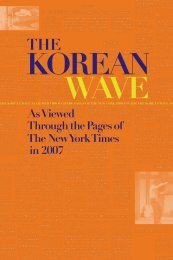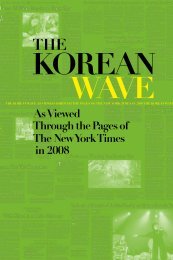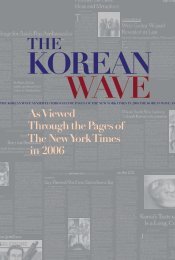The Korean Wave 2010-2011 - Korean Cultural Service
The Korean Wave 2010-2011 - Korean Cultural Service
The Korean Wave 2010-2011 - Korean Cultural Service
Create successful ePaper yourself
Turn your PDF publications into a flip-book with our unique Google optimized e-Paper software.
<strong>The</strong> New York Times, Friday, June 3, <strong>2011</strong>C4classical-music world needs to be shakenup a little bit,” said Vicki Margulies,“<strong>The</strong>artist manager for Young Concert ArtistsInc., which selected Hahn-Bin to perform at theMorgan. “And he’s the one to do it.”Hahn-Bin credits Mr. Perlman and the star architectPeter Marino, who financed his New York concert debutin 2009 at Zankel Hall, part of Carnegie Hall,for teaching him how to straddle two cultural worlds.“<strong>The</strong> only person that understood that I was a genreof my own was Mr. Perlman,” he said. “He gets thatI have always been a performance artist who singsthrough the violin.”In a phone interview, Mr. Perlman said: “He is an extremelytalented violinist who is very, very individual.He combines music with drama and a visual element.It’s very personal to him. When an artist feels it thatpersonally, the audience does, too.”Hahn-Bin’s diverse group of fans also includes thefashion personality André Leon Talley, the art mavenShala Monroque, the magazine editor Stephen Ganand the gallerist Barbara Gladstone. “In the contextof classically trained musicians, he is quite startling,as they are hardly given to personal theater,” Ms.Gladstone said.He collaborated with the video artist Ryan McNamaraon “Production,” a performance at the Louis Vuittonstore during Fashion’s Night Out last year, and hewalked the runway for the designer Elise Overland lastSeptember. This month, he performed at the Stone, anart space in the East Village, in a show curated by themusicians Lou Reed and Laurie Anderson; and playedsoliloquies inspired by the exhibition “Andy Warhol:Motion Pictures” at the Museum of Modern Art.“<strong>The</strong> movement, his body, his clothes, his style, hisdramaturgy and the music, of course, form one strong,complex, multilayered audio-visual image,” said KlausBiesenbach, chief curator at large for the museum.Hahn-Bin said that defying genres in this manner isan intrinsic part of his personality. “I have never identifiedas Asian or American, boy or girl, classical orpop,” he said.He was born in Seoul, South Korea; his family movedto Los Angeles when he was 10 so he could study atthe Colburn School of Performing Arts. As a teenager,he would tell his mother he was going there to practicethe violin, then sneak off to see performances byMs. Anderson or the avant-garde playwright RobertWilson. He moved to New York in 2004 after beingaccepted into Juilliard, where he quickly felt like “astrange fruit,” he said. His classmates didn’t understandwhy he studied the work of the musician Björk andthe photographer Nick Knight along with Kreisler andDvorak. “<strong>The</strong>y would tease me endlessly,” he said.Between classes, he’d shop at downtown boutiques likeSeven New York and Yohji Yamamoto, then return toclass decked out in Bernhard Willhelm and MartinMargiela. “Everyone’s jaws would just drop,” he said.“I fought with the deans constantly about what I couldwear. <strong>The</strong>y finally told me I can wear something allblack. Naturally, I went onstage wearing a top thathad a very deep V-neck. I will never forget when theorchestra manager ran to me backstage with a safetypin in horror.”Hahn-Bin said that his use of fashion is part of an attemptto make classical music (“the new undergroundgenre,” he said) relevant to a group of young peoplewho may have been dragged to concerts by theirgrandparents. He also posts relentlessly on his Website, Twitter, YouTube and Facebook. “He is speakingdirectly to his generation,” Ms. Margulies said. “Thisis his world.”With these bells and whistles comes the occasionalaccusation that his persona distracts from the music.“<strong>The</strong>re are many people in my field who have tried totell me what I should and shouldn’t do with Mozart orBeethoven, even to this day,” he said.But Mr. Perlman dismissed any idea that Hahn-Bin’sself-stylization is gimmickry. “It’s not like he is followinga trend in classical music right now,” he said. “Heis setting the trend.”At the Morgan, this trendsetting included three costumechanges from the kimono: a Karl Lagerfeld-esquetuxedo with an oversize flower pin; an asymmetricalshirt dress with an eye mask made from feathers; anda boxy red blouse with a plunging V-neckline, accessorizedwith a pair of Jeremy Scott sunglasses andthigh-high Rick Owens boots.“Honestly, to get onstage and balance in my shoes isa lifetime achievement in of itself,” Hahn-Bin said.“Dancers have arms to help find their balance, butone of my arms, you see, is doing the most ridiculousthings with the violin.”Instrumentalistsat an ExhibitionBy ZACHARY WOOLFEIn the left panel of Simon Dinnerstein’s painting“<strong>The</strong> Fulbright Triptych” a woman sits with achild on her lap. In the right panel a man also sitsin a neutral posture. All three stare blankly out at theviewer.<strong>The</strong> center panel is dominated by a table covered withsharp, almost surgical-looking printers’ implements.Two picture windows behind it show an idyllic viewdown the road of a country town.At a recital on Wednesday in the galleries of the Tenri<strong>Cultural</strong> Institute, the painting hung next to the players:the violinists Angela and Jennifer Chun, who aresisters, and the pianist Frederic Chiu. <strong>The</strong>y seemedinspired by its eerie mixture of knife and landscape,aggression and idyll.<strong>The</strong> Chuns in particular eschewed simple, folksy nostalgiain a program inflected with the tangy harmoniesand dancing rhythms of Eastern European music.<strong>The</strong>ir interpretations and tone were cutting and severe,accentuating the strangeness of the works and emphasizingtheir modernism.<strong>The</strong>y and Mr. Chiu are old Juilliard classmates. Allthree now record on the Harmonia Mundi label, andthere was a sense of shared history, an easy intimacy,in the program, which was called “Ballad and Dance”after the title of a short Ligeti work for two violinsbased on Romanian folk songs.<strong>The</strong> recital opened with some of Bartok’s 44 ViolinDuos (around 1933) interspersed with selections fromProkofiev’s “Fugitive Visions” for solo piano (1915-17).Mr. Chiu’s suave playing and subtle touch — thosedelicate high notes! — acted like a tonic to the violinists’intense, bracing duos.<strong>The</strong>ir Chuns’ astringent style was effective in theBartok, but less so in Shostakovich’s rhapsodic “ThreeDuets for Two Violins and Piano.” <strong>The</strong>y seemed intenton adding rawness and edge to these ingratiating pieces,but here it was too much. <strong>The</strong>y were more convincingin Isang Yun’s Sonatina for Two Violins (1983),its suspended harmonics slowly building in waves ofsound, and Martinu’s playful, elegant Sonatina forTwo Violins and Piano (1930).But Mr. Chiu was the recital’s star, bringing exquisiteseriousness to Gao Ping’s potentially gimmicky “TwoSoviet Love Songs for Vocalizing Pianist” (2003).<strong>The</strong> work had some of the impressionist feel of theProkofiev, with Mr. Chiu softly whistling and hummingover crystalline filigree work at the very topof piano’s range. Inspired in part by video of GlennGould singing to himself as he played, the work hadthe same quality that gave Gould’s performances somuch of their power: the sense of spying, of watchingsomething you weren’t supposed to see.16 Copyright © 20011 by <strong>The</strong> New York Times Co. Reprinted with permission.Copyright © 20011 by <strong>The</strong> New York Times Co. Reprinted with permission. 17





